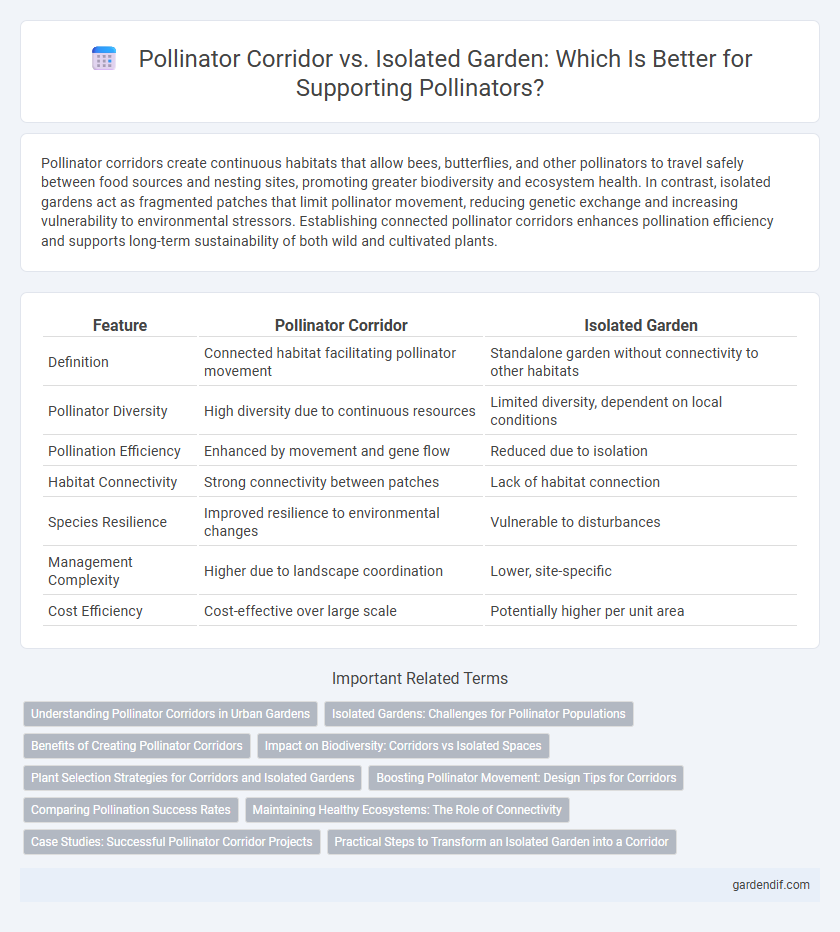
Pollinator Corridor vs Isolated Garden Illustration
Pollinator corridors create continuous habitats that allow bees, butterflies, and other pollinators to travel safely between food sources and nesting sites, promoting greater biodiversity and ecosystem health. In contrast, isolated gardens act as fragmented patches that limit pollinator movement, reducing genetic exchange and increasing vulnerability to environmental stressors. Establishing connected pollinator corridors enhances pollination efficiency and supports long-term sustainability of both wild and cultivated plants.
Table of Comparison
| Feature | Pollinator Corridor | Isolated Garden |
|---|---|---|
| Definition | Connected habitat facilitating pollinator movement | Standalone garden without connectivity to other habitats |
| Pollinator Diversity | High diversity due to continuous resources | Limited diversity, dependent on local conditions |
| Pollination Efficiency | Enhanced by movement and gene flow | Reduced due to isolation |
| Habitat Connectivity | Strong connectivity between patches | Lack of habitat connection |
| Species Resilience | Improved resilience to environmental changes | Vulnerable to disturbances |
| Management Complexity | Higher due to landscape coordination | Lower, site-specific |
| Cost Efficiency | Cost-effective over large scale | Potentially higher per unit area |
Understanding Pollinator Corridors in Urban Gardens
Pollinator corridors in urban gardens create continuous pathways of flowering plants that support diverse pollinator species by providing consistent foraging and nesting habitats, which isolated gardens often lack. These corridors enhance pollinator movement and gene flow, improving ecosystem resilience and crop pollination efficiency across fragmented urban landscapes. Research shows urban pollinator corridors increase species richness by up to 40% compared to isolated gardens, fostering sustainable biodiversity within cities.
Isolated Gardens: Challenges for Pollinator Populations
Isolated gardens face significant challenges for pollinator populations due to limited habitat connectivity, which restricts foraging range and gene flow among pollinators. These fragmented environments reduce floral diversity and nesting sites, leading to decreased pollinator abundance and increased vulnerability to environmental stressors. The lack of corridors impairs pollinator movement, ultimately threatening colony resilience and pollination services essential for ecosystem health.
Benefits of Creating Pollinator Corridors
Pollinator corridors enhance biodiversity by connecting fragmented habitats, allowing bees, butterflies, and other pollinators to move freely between floral resources, which boosts pollination efficiency and plant reproduction. Unlike isolated gardens, corridors support genetic diversity and resilience in pollinator populations by facilitating gene flow and reducing risks from habitat fragmentation. Creating pollinator corridors promotes ecosystem stability and agricultural productivity through improved pollination services across larger landscapes.
Impact on Biodiversity: Corridors vs Isolated Spaces
Pollinator corridors significantly enhance biodiversity by connecting fragmented habitats, allowing for safer and more efficient movement of species such as bees, butterflies, and birds. Isolated gardens, while beneficial on a small scale, often restrict gene flow and reduce species diversity due to their limited spatial range. Studies show that corridors increase pollinator abundance and plant-pollinator interactions, which are critical for ecosystem resilience and species survival.
Plant Selection Strategies for Corridors and Isolated Gardens
Pollinator corridors prioritize native, nectar-rich, and early-blooming plants to support continuous food sources and habitat connectivity across landscapes, enhancing pollinator movement and diversity. Isolated gardens benefit from a diverse mix of flowering plants with staggered bloom times, including host plants for specific pollinators, to maximize localized pollinator attraction and sustain populations despite habitat fragmentation. Strategic plant selection in corridors emphasizes spatial arrangement and connectivity, while isolated gardens focus on maximizing floral diversity and resource availability within limited space.
Boosting Pollinator Movement: Design Tips for Corridors
Pollinator corridors significantly enhance pollinator movement by providing continuous, resource-rich habitats that support foraging and nesting across landscapes, unlike isolated gardens which often limit pollinator access and diversity. Incorporating diverse native flowering plants with staggered bloom times within corridors maximizes nectar and pollen availability, encouraging consistent pollinator activity. Designing corridors with structural variety--such as shrubs, wildflowers, and nesting sites--facilitates movement, improves habitat connectivity, and supports a broader range of pollinator species.
Comparing Pollination Success Rates
Pollinator corridors demonstrate significantly higher pollination success rates compared to isolated gardens due to enhanced connectivity that supports diverse pollinator species movement. Studies indicate pollination efficiency increases by up to 40% in corridors, facilitating cross-pollination and genetic diversity in flowering plants. Isolated gardens, in contrast, often suffer from reduced pollinator visits and limited gene flow, resulting in lower fruit set and seed production.
Maintaining Healthy Ecosystems: The Role of Connectivity
Pollinator corridors create continuous pathways that enhance gene flow and species movement, vital for sustaining healthy ecosystems and biodiversity. Isolated gardens often lack connectivity, limiting pollinators' access to diverse floral resources and reducing ecosystem resilience. Maintaining connected habitats supports ecosystem services like pollination, promoting long-term ecological balance and agricultural productivity.
Case Studies: Successful Pollinator Corridor Projects
Pollinator corridor projects have demonstrated significant improvements in biodiversity and pollination rates compared to isolated gardens, as evidenced by case studies in urban and agricultural landscapes. In the Pacific Northwest, the establishment of continuous wildflower corridors increased native bee populations by over 40%, whereas isolated gardens experienced limited pollinator visitation and species diversity. These findings underscore the ecological benefits of connected habitats in supporting pollinator health and ecosystem resilience.
Practical Steps to Transform an Isolated Garden into a Corridor
Creating a pollinator corridor from an isolated garden involves planting diverse native flowering plants that bloom sequentially to provide continuous nectar sources. Connecting fragmented habitats with pollinator-friendly vegetation enhances species movement and genetic exchange, boosting ecosystem resilience. Implementing layered vegetation structures, including ground cover, shrubs, and trees, supports diverse pollinator species and fosters sustainable pollination networks.
Pollinator Corridor vs Isolated Garden Infographic

 gardendif.com
gardendif.com